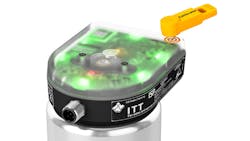Precision Valve Monitoring Technology Turns the Corner
At a Glance:
- Responding to demand for a smaller footprint and greater capabilities, new valve-sensing systems provide accuracy, reliability and convenience for applications using hygienic diaphragm valves.
- The Integrated Sensing Platform (ISP) is designed with the hygienic industry in mind.
- This non-contact, magnetic sensor technology can be automatically calibrated with a dongle or the ISP app and can read the entire range of a skid.
For decades, precision monitoring of diaphragm valves has been a kind of good news/bad news proposition for the BioPharm and hygienic industries. Successive generations of monitoring technologies have helped manufacturers track the performance of valves, which is essential for operational consistency. However, those capabilities come in bulky packages.
Why? Because, in general, makers of monitoring devices have prioritized functionality over form factor. The desire to deliver a universal solution has led to larger envelopes that can be bigger than the actuators being monitored. The result: a variety of unwieldly, mechanical units that are challenging to install, operate and maintain. What’s more, upgrading to a newer unit could mean replacing an old bulky unit with a new bulky unit.
When weighing these pros and cons, manufacturers will often settle on a two-part solution for their plants: no-touch monitoring devices for mission-critical equipment and a mix of older technologies for the balance of their operations. It is a pragmatic approach, but still problematic because manufacturing equipment is getting smaller and more specialized.
Engineered valves need to fit into tight spaces. The more compact the skid, the harder it is to accommodate bulky, old-school monitoring devices. BioPharm manufacturers (and their suppliers) have asked for a better solution with a smaller footprint and greater capabilities. Manufacturers are responding with new valve-sensing systems that provide the level of accuracy, reliability and convenience for applications using hygienic diaphragm valves.
Addressing Legacy Challenges
In hygienic industries, reliable information about operations is critical to success. Among BioPharm companies, for example, products represent not only a huge investment, but also a huge commitment to public health. Protecting the integrity of every ingredient and every solution is key to maintaining public trust.
Non-contact sensing technology offers a superior solution for operational and quality control because magnetic sensors can read the entire range of an individual valve. When networked together, non-contact sensing units can assess the performance of entire skids or an entire facility. This allows manufacturers to know that each process is working as intended.
As an example, ITT Engineered Valves’ Integrated Sensing Platform (ISP) uses magnetoresistive sensing, technology which is used extensively in the automotive industry for its reliability and repeatability. The ISP is packed with advanced calibration capabilities that enable smooth operation and communication with diaphragm valves. Highly accurate and resistant to temperature fluctuations, the ISP technology continuously senses the entire stroke range. The contact-free architecture assures long life expectancy with no component wear. There are no linkages to bend or bind and no contacts to corrode.
Older technologies, such as mechanical switches, wear down over time and become less reliable. This wear-and-tear can be difficult to detect, and operational risks such as process errors and nuisance false alarms are more likely to occur. These are costly events because highly paid maintenance staff must investigate every incident to determine cause and corrective measures.
At a minimum, the cost per incident is $1,000. Say a facility has 500 valves with monitoring sensors. Even if only 1% of the valves had a false alarm each time a process was run, that could lead to upwards of 60 false alarms in a year. That’s $60,000 total for false alarms, which has a sizable impact on budget. Furthermore, even when older mechanical systems are working smoothly, they still require time-intensive troubleshooting, which contributes to higher costs.
Combining Valve Expertise with Network Communications
The ISP is compatible with small, fractional valves (.25, .375, 0.5) all the way to 3- and 4-in. valves with the 33 series actuators. It is about one-third the size of alternative products that perform similar functions. The space-saving interface between the ISP and valve actuator minimizes overall valve installation height and keeps electronic module inventory to a minimum. The integrated internal solenoid eliminates bulky external accessories and allows for simple override of the ISP for operation and commissioning. The ISP is compatible with Engineered Valves’ portfolio of hygienic valves, including the EnviZion, Pure-Flo and Dia-Flo valve lines.
For ease of use, the ISP can be calibrated in a number of ways depending upon the specific options and output protocols. All units can be calibrated with a magnetic dongle. 3 Wire and network modules featuring diagnostics and control can be remotely calibrated via Bluetooth on an iPhone or iPad with the ISP app. The automatic calibration reduces start-up and commissioning time, getting users into operation faster.
While the Bluetooth calibration is quick and easy, built-in security measures prevent the unit from being calibrated while connected to the network or PLC. One person can calibrate an ISP device in less than a minute. By comparison, other systems may require multiple people working on calibration, and the process for a single unit can take upwards of 30 minutes.
High-visibility LEDs allow the user to clearly see the valve position and calibration status. And to make it easier to locate specific valves, the ISP app includes a wink command that triggers the LED lights to blink, so that an operator can quickly locate components that need attention. For larger facilities with thousands of valves, greater visibility translates into greater efficiency for maintenance crews.
The ISP app also offers users the ability to track valve performance over time and to log specific valve information (opening and closing times, ISP unit temperature and error codes) and maintenance history. The historical data can be easily accessed and reviewed via the app.
Optimizing Equipment and Performance
While the day-to-day benefits of the ISP are clear for the end-user, it is important to point out that the value of the system extends to other players in the value chain.
Drug manufacturers, for example, may specify what kind of equipment are used in their plants. However, a third-party engineering firm is usually hired to design the system. From there, any number of skid builders can be responsible for assembling the component parts. Because this is a team effort, it is important that each player understands the advantages of the ISP compared to alternative sensing technologies. That way they can collaborate on the best configuration.
This is important in light of the pharmaceutical industry’s shift toward smaller skids, which are attractive for a variety of reasons. Compact skids make it possible to perform more processes per square foot in clean rooms, which can cost $200-$500 or more per square foot to build. Smaller skid units also have less risk of product loss due to much lower hold-up volume in the piping. Additionally, they require less CIP (clean-in-place) and SIP (steam-in-place) which makes them more cost effective to operate.
Smaller skids also are more efficient and have less product loss compared to larger skids, as they hold up lower volume in the piping. Because the ISP is more compatible with smaller skid units, it is worthy of consideration when designing and building production equipment.
With the need for efficiency manufacturers can’t rely on legacy monitoring technology. They need to be as efficient and agile as possible in the face of increased competition. Choosing the right monitoring solution can help manufacturers get the best performance out of their equipment in the short term. Plus, the ability to collect precise diagnostic data over time builds valuable operational insight that can improve productivity for the long term.
Dave Loula is global product director and Paul McClune is product manager at Engineered Valves.



